Jainavenue is a medium to serve the spiritual path of Jainism
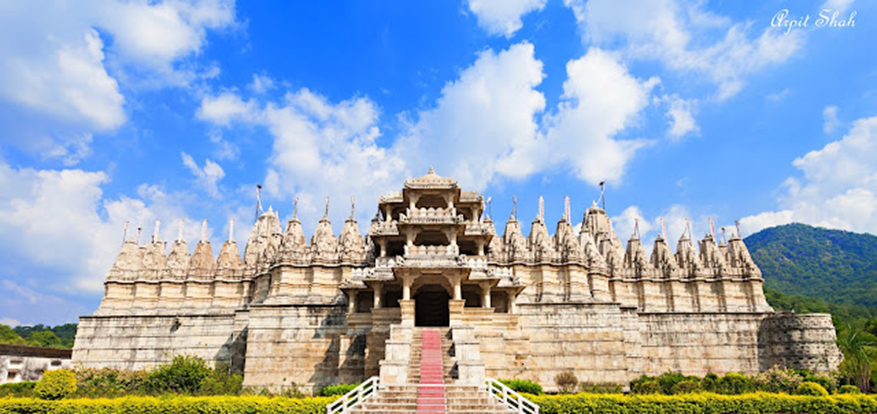
The magnificent Ranakpur Jinalay
2) Dedicated to Lord Adinath, the first tirthankar of Jainism, the Chaumukhi (4-sided) temple is a three-storeyed marble edifice placed on a lofty plinth standing on 1,444 artistically carved pillars. Although, Rajasthan is famous for its rich architectural heritage, the Ranakpur Jain Temple is an exemplary work of art and architecture and is an eloquent testimony to the Maru-Gurjara style of architecture.
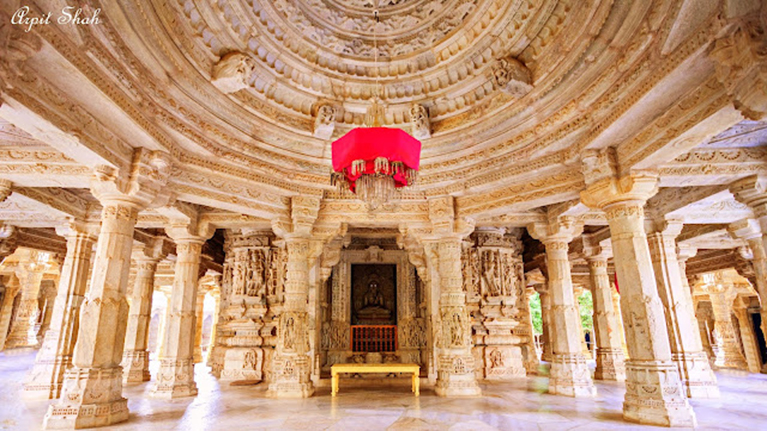
The Divine Abode !

Mulnayak Shri Adinath Bhagwan
3) Built by Rana Kumbha’s advisors, Sheth Dharana Shah and his younger brother Ratna Shah the design of the temple was made based on the divine dream of Dharana Shah wherein he experienced a vision of Nalinigulm Vimaan (celestial floating palace) of the 12th Devlok.
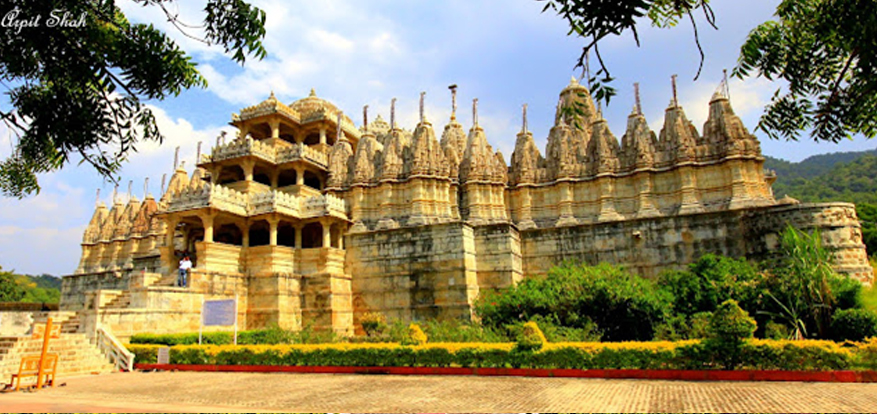
The Nalinigulm Viman Praasaad
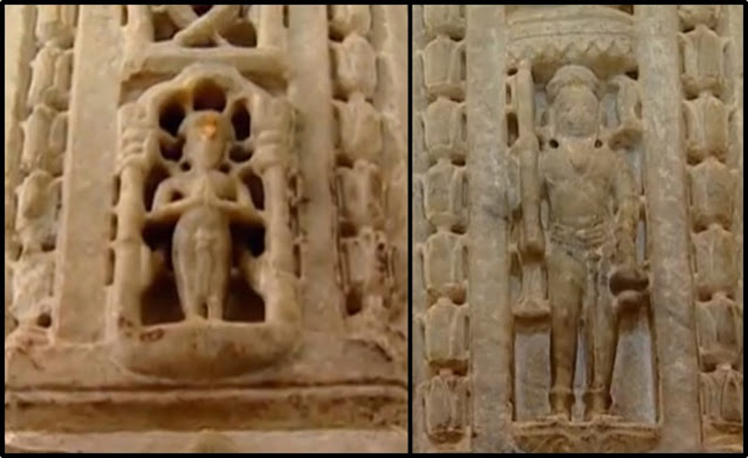
Dharana Shah (left) and Depa (right)
4) Under the holy guidance of Acharya Shri Somchandrasurishwarji Maharaja, the construction of the divine temple was initiated in Vikram Samvat 1446 with the Khanan Vidhi, wherein the foundation stone was laid 35 feet deep inside the earth filled with Saptadhatu, including gold, silver, and various precious gems.
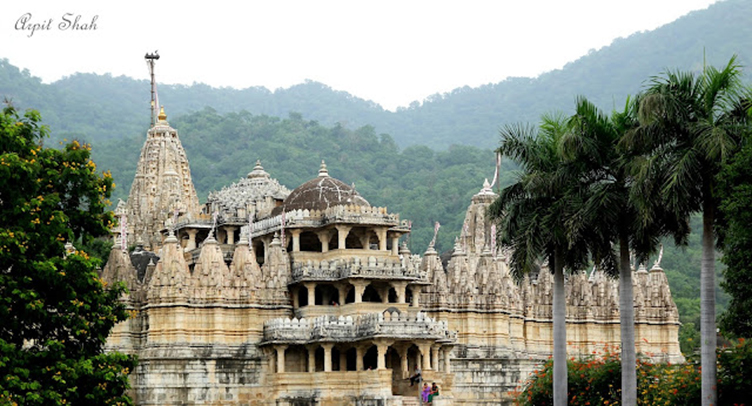
Tucked in the midst of Aravalli Hills
5) Sheth Dharana Shah invited many renowned artists and sculptors to replicate his dream, but none could succeed. After years of search, a simple yogi named Depak (or Depaa) presented a plan, which simply thrilled the heart of Dharana Shah. Depak was a carefree artist who preferred poverty over riches.

Intricate carvings adorning the temple
6) It is believed that a sum of 15 crore was spent by Sheth Dharana Shah on the construction of the temple (in that era!) which took 50 years to complete. As per one of the legends, once the Sheth was making an early morning round to inspect the progress of construction when he found a night-lamp burning. Immediately he blew off the lamp to save the wastage of “ghee” (clarified butter). Witnessing this, one of the labourers taunted the Sheth, saying that even rich people are miserly enough not to leave a lamp burning. The Sheth in reply, asked all the labourers to stop using water to make the bindings for the stones and use ghee instead! It is widely believed that ghee was used instead of water to bind the marble and sandstone slabs together.
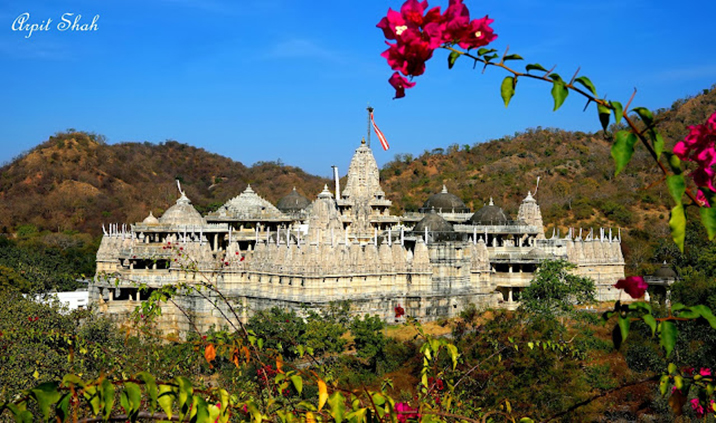
Bird’s eye view of the Temple
7) The temple has four entrances. In the main chamber or Garbha Griha (Sanctum sanctorum), four white marble idols measuring 72 inches dedicated to Lord Adinath have been installed facing towards the four different directions. Apart from the Garbha Griha, 76 small shrines, four Rang-mandaps (assembly halls), four Mahadhar Praasaads (Principal Shrines) are situated in the four directions. A total of 84 Devakulikas (subsidiary Shrines) stand embellishing the temple, soliciting and inspiring man to strive for emancipation from cycles of 84 lakhs of birth and death and attain eternal salvation.
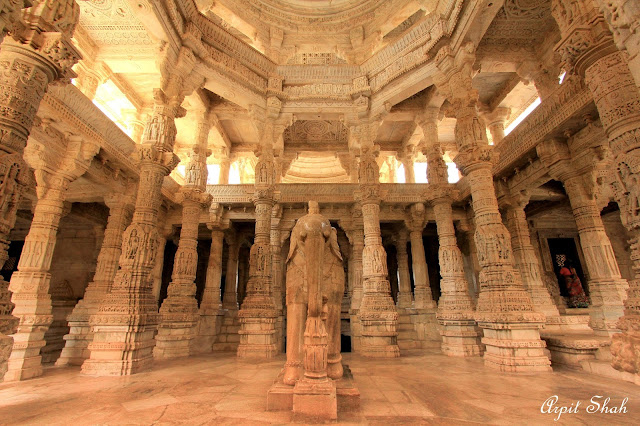
The beautiful Rangmandap
8) The temple, spread over an area of 48000 square feet is also known as the “Dharan Vihar (based on the name of Dharana Shah)”, “Trailokya Deepak Praasaad (The temple of the light of the three worlds) and “Tribhuvan Vihar” (the abode of the lord of the three worlds).
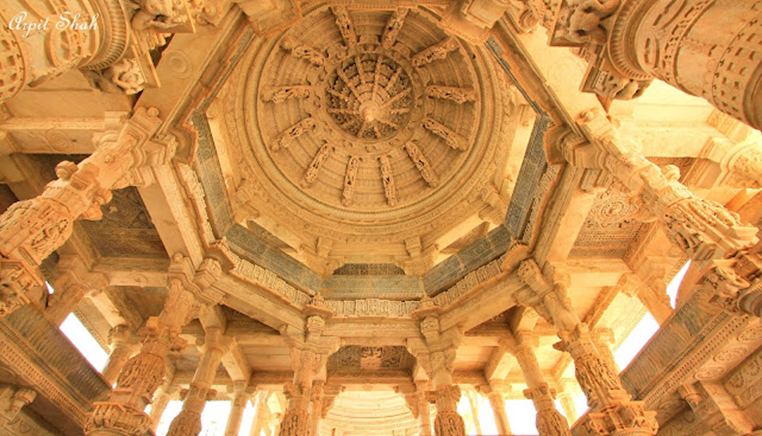
The majestic Meghnaad Mandap
9) The 40 feet high pillars of the “Meghnad Mandap” have been intricately carved delicately and the magnificent dome with its delicately carved inverted lotus simply keep one’s eyes glued to them. On the left of the Meghnad Mandap on one of the pillars, the statuettes of Sheth Dharana Shah and Depak have been carved with their hands folded in reverence to the lord.
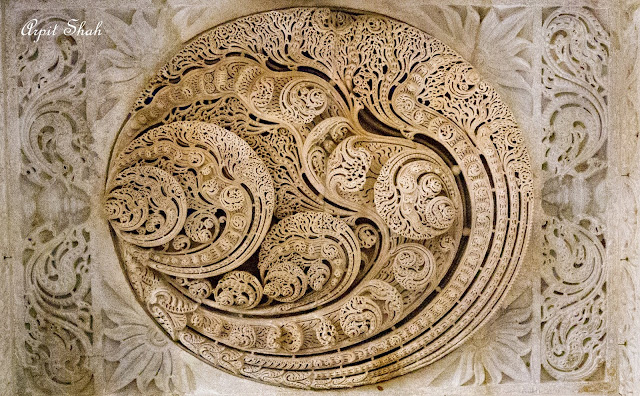
The wish fulfilling Kalpavriksha Leaf carving
10) One of the most exquisite carvings in the temple showcases the “Leaf of the Kalpa-vriksha (wish fulfilling tree)”. It is widely believed that this carving fulfils all human desires!
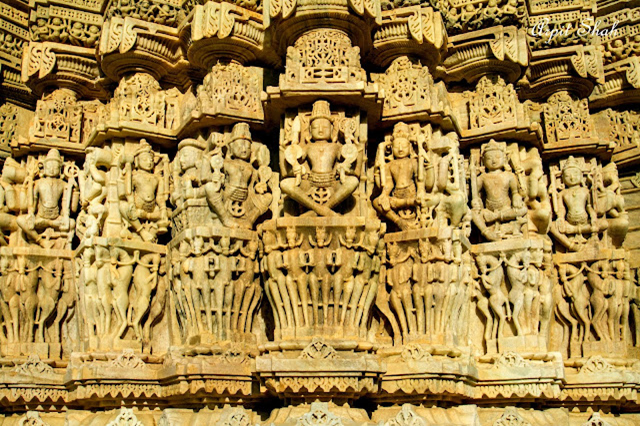
The intricate carvings on the exterior
11) The most outstanding feature of this temple is its infinite number of pillars – 1,444 in total. The pillars have been arranged in such a manner that none of them obstruct the view of the lord! The best feature about these pillars is that no two pillars are alike in design and sculpture.
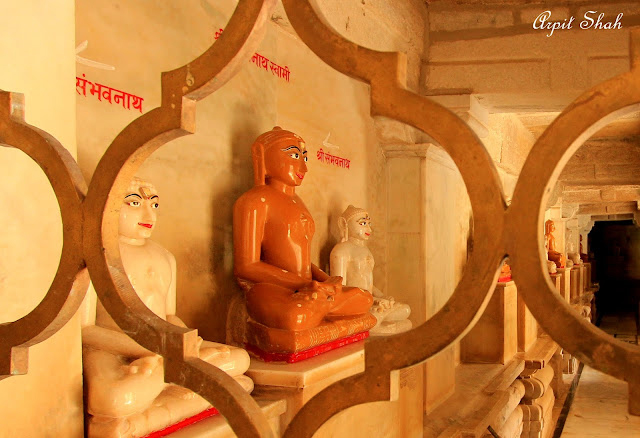
Ancient idols inside the Devkulika’s
12) The temple also houses 9 underground vaults in which the idols could be safely preserved in the event of a crisis. It is believed that there are many idols still present in these cellars. It is said that after the completion of the temple, Rana Kumbha wished to make a Kirtistambh (victory tower) for his fame, but as divine power would have it, it remained incomplete. It is called Adhuro Thambhalo (the incomplete pillar).
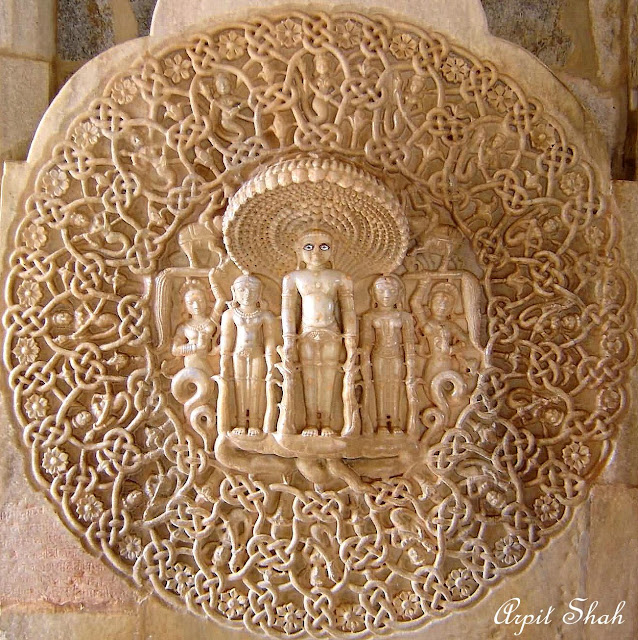
The intricately carved idol of Lord Sahastrafana Parshwanath Bhagwan
13) One of the most beautifully carved idol is dedicated to Lord Sahastrafana Parshwanath depicting Dharnendra Dev and Padmavati Devi protecting the lord from the atrocities given by Kamath. The idol is carved in a single stone and 1008 hoods have been carved over the lord. The tails of male snakes and female snakes are very artistically interwoven creating an illusion that they are interlinked.
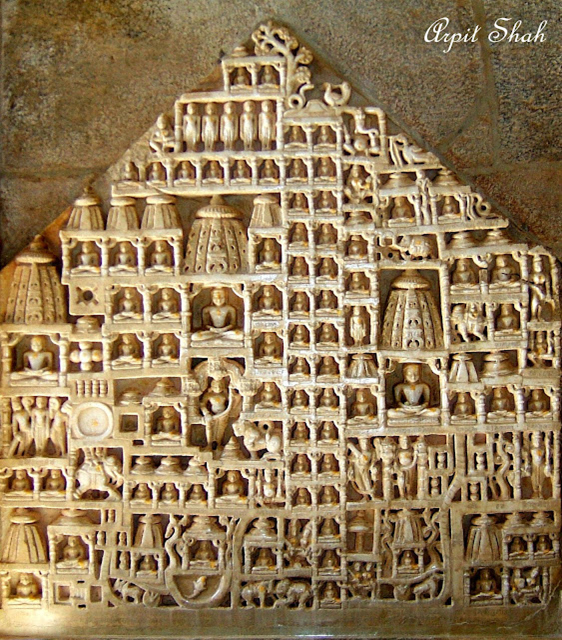
Mt. Shatrunjay carved on a marble slab
14)Two large pairs of bells, weighing 108 kg each are housed inside the temple. It is believed that the sound of the bell lasts for a minute and reaches as far as 3 miles from the temple.
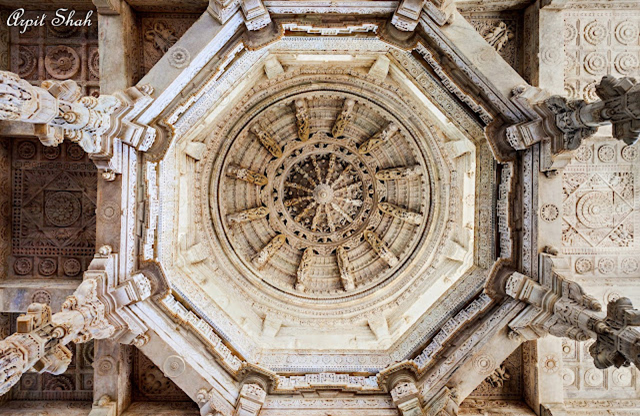
The beautiful carvings
15) A Rayan tree (Manilkara Laxandra) which was planted by Dharna Shah, is present even today. The feet of Lord Adinath have been carved here signifying that the lord attained omniscience under a Rayan tree. In the center to the right of the temple, a Samavasaran of Lord Mahavir is very artistically constructed in marble.
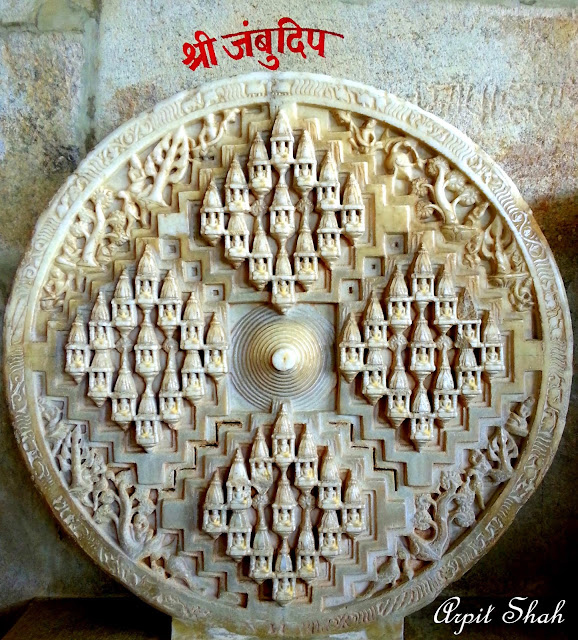
Jambudweep Carvings
16) The temple has been designed in such a way that the walls stay warm during the winters and offer coolness during summers. The temple accommodates 29 halls and 80 domes.
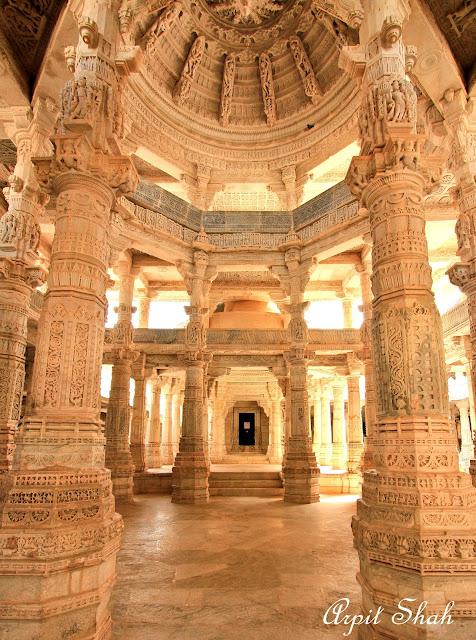
The temple of 1,444 pillars !
17) Two other temples, dedicated to the Ranakpura Parshwanath Bhagwan (one of the 108 holy shrines of Lord Parshwanath) and Lord Neminath Bhagwan are also situated within the temple compound. The Neminath Temple was built by Somal Porwal who was the Munim of Dharna Shah. This temple is (in)famous for its erotic carvings depicted on its outside walls which portray the Sansarik life of Acharya Sthulibhadra (before taking Diksha) and Kosha Vaishya.

The Ranakpura Parshwanath Jinalay
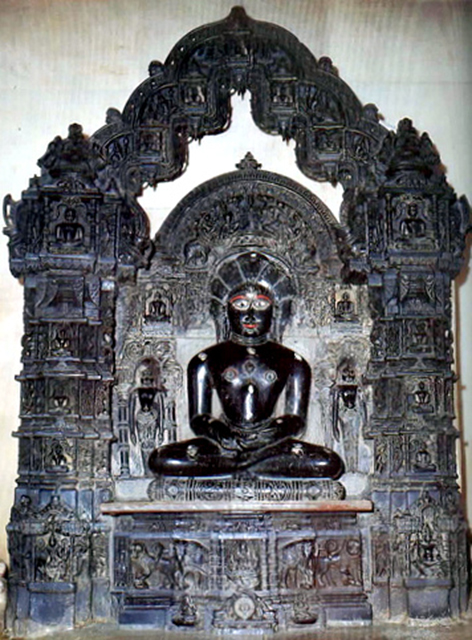
Shri Ranakpura Parshwanath

Erotic Carvings in outer walls
18) The eroding sweep of time led to a harsh period for the temples. For years the temple was abandoned due to frequent wars and invasions which led to infestation of wild animals and dacoits. During that period, the temple was managed by some pujaris whose descendants still work in the temple till this day. (Due to this, the pujaris have not allowed to keep a “Bhandaar” inside the temple and all offerings made inside the temple go directly to the pujaris and not the temple trust).
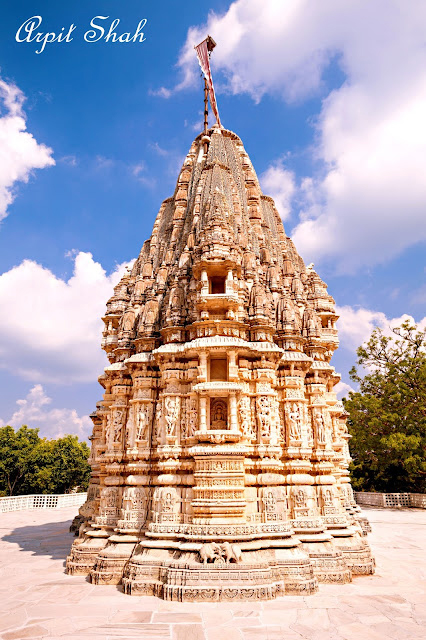
The Neminath Swami Jinalay
19) Fortunately, in the Vikram Samvat 1953, the congregation of Sadri, handed over the administration of this shrine to Sheth Anandji Kalyanji Trust. The trust then launched an ambitious programme of renovating the temple which took 11 years to complete.
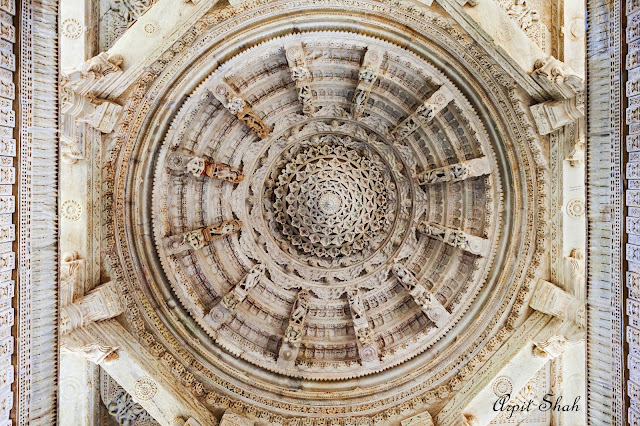
The inverted lotus !
20) The temple is open to Jain pilgrims only from dawn to 12 noon post which all tourists are allowed entry. Photography is permitted at a fee of Rs. 100 per camera. Do make sure to use the facility of an audio guide which is available in multiple languages for a small sum of money. Ranakpur is 30km from the town of Falna, 90 km from Udaipur and 160 km from Jodhpur. The nearest railhead to reach Ranakpur is Falna Railway station, and the nearest airport is Udaipur.
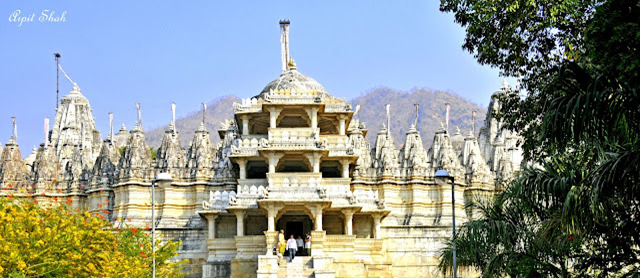
Kaam aisa kariyo, jo Dhanna Sheth ne kariya, Ranakpur banva ke jag me naam kar diya !
About Author
Arpit Shah is an avid history researcher, devotional singer, and a Jain “vidhikarak” based out of Kolkata. He is a CS and MBA by qualification and works full time at a MNC. He has authored 3 critically acclaimed books (“Dharma Saarthi”, “Prabhu Tamara Pagle Pagle” & Jin Puja – Itihas ke Panno se”) along with 50+ articles on Jain Heritage.



Your point of view caught my eye and was very interesting. Thanks. I have a question for you.
Your point of view caught my eye and was very interesting. Thanks. I have a question for you.